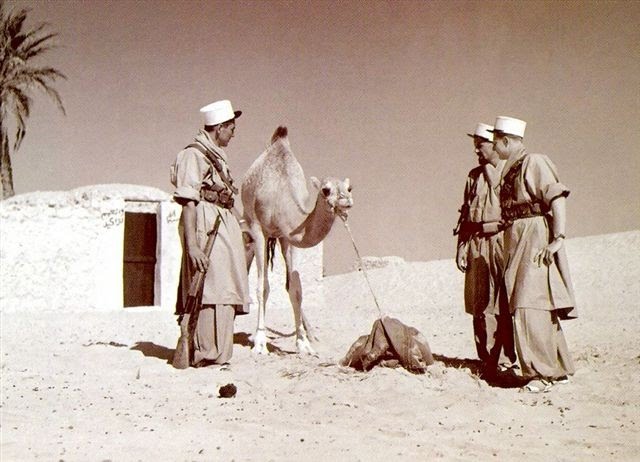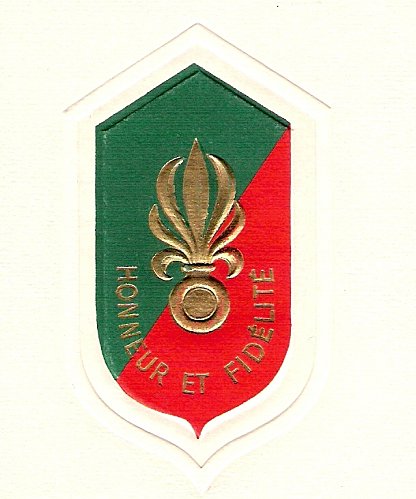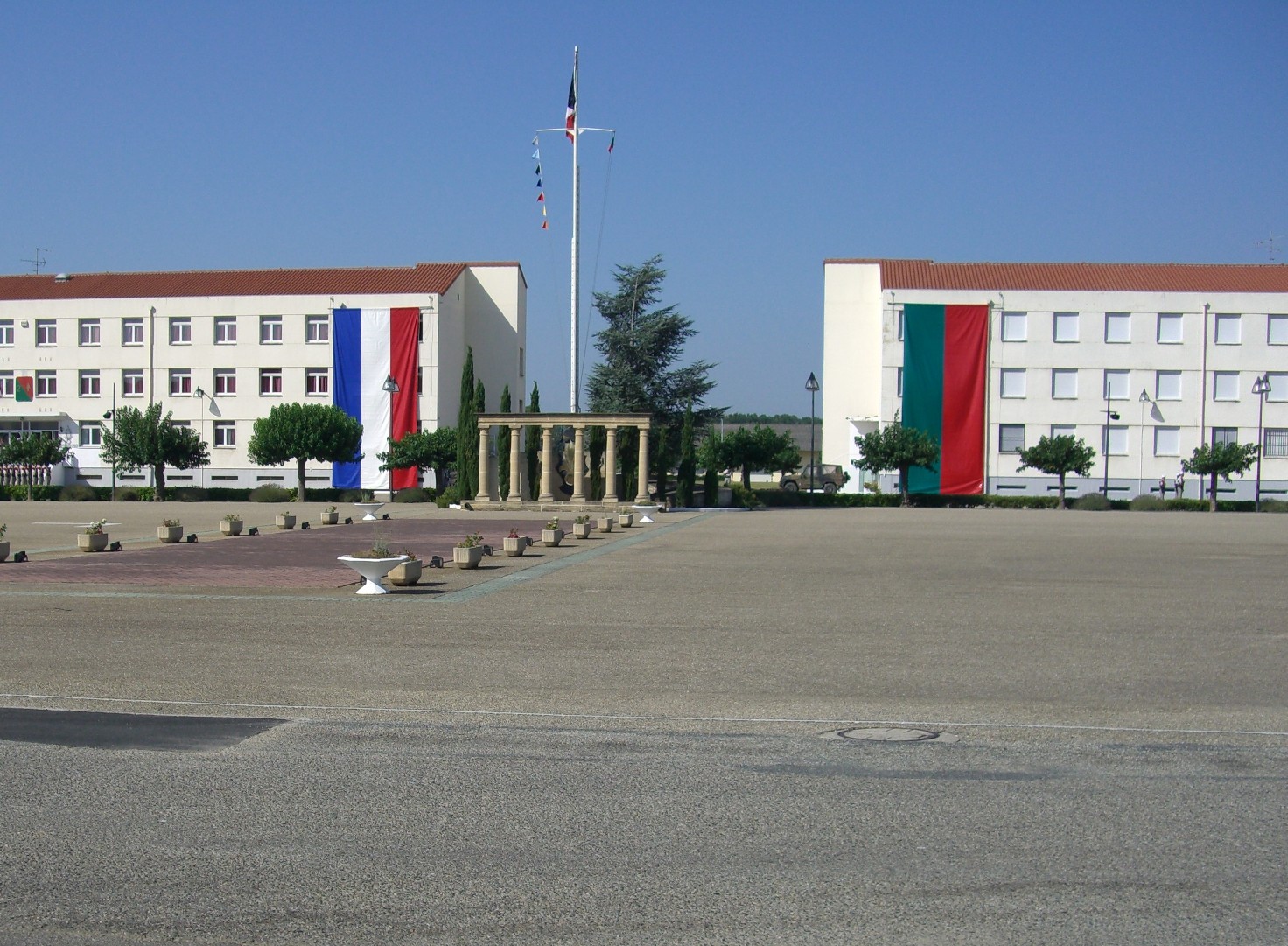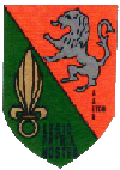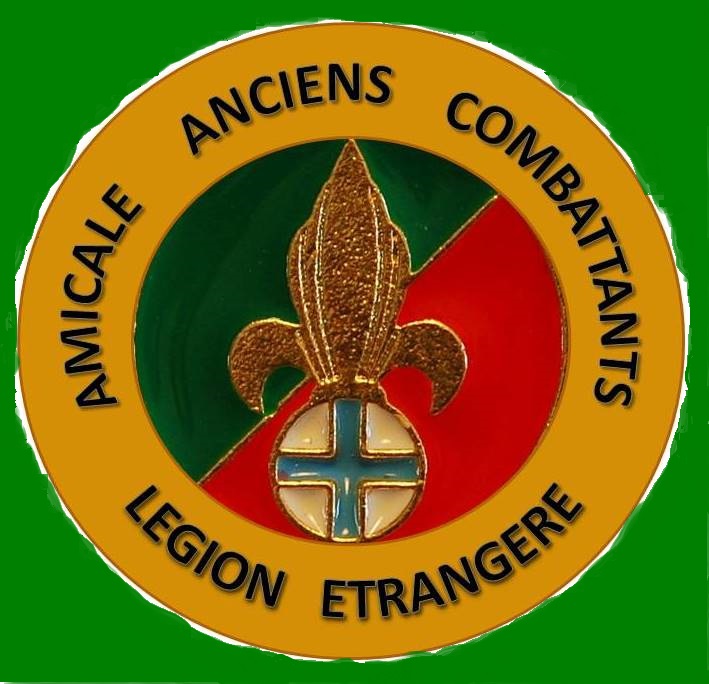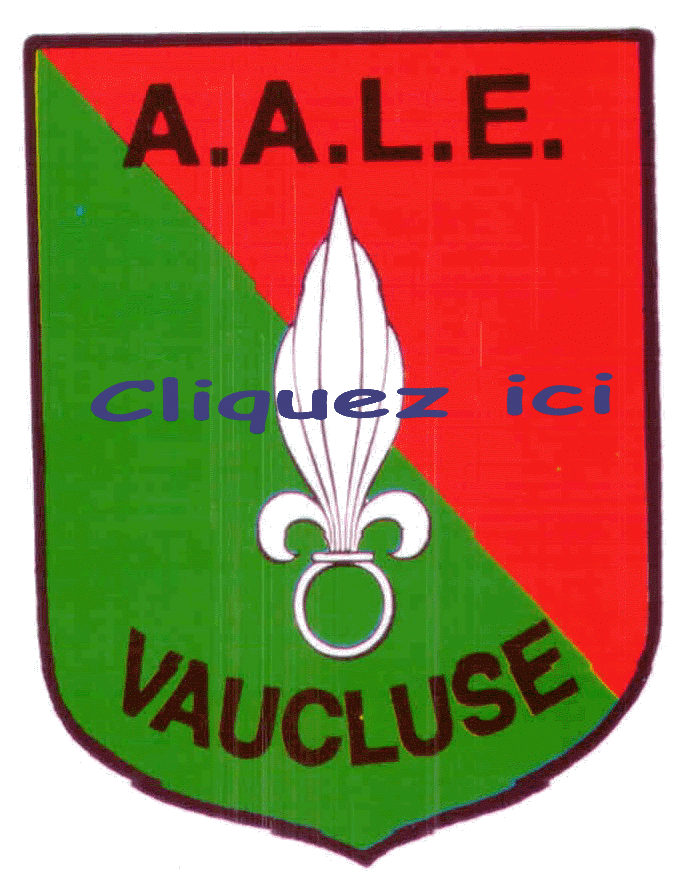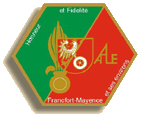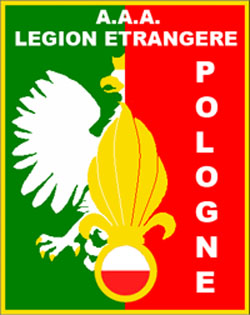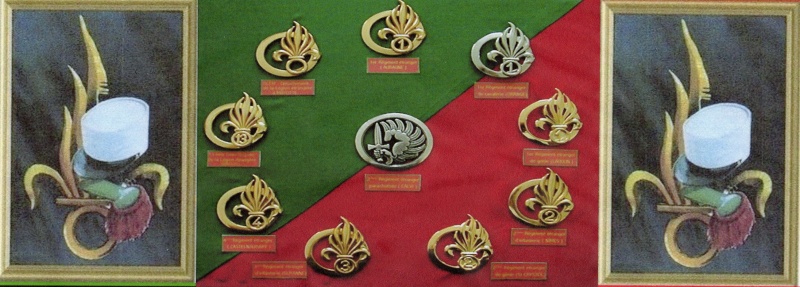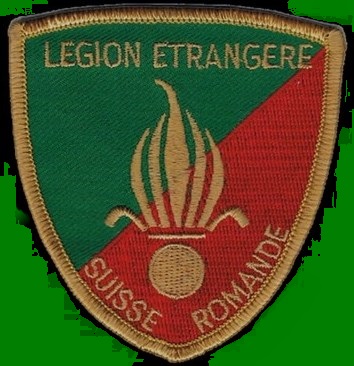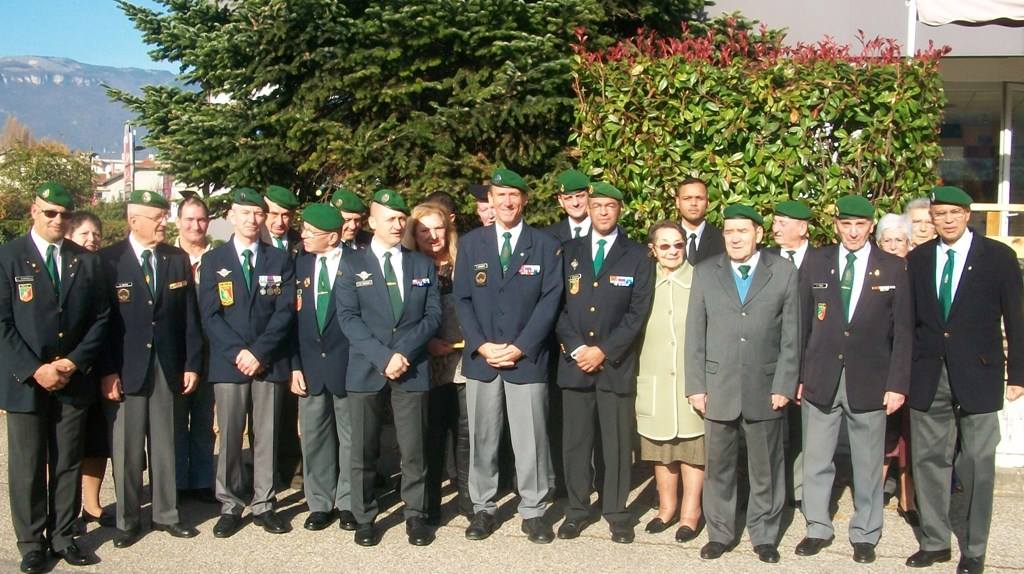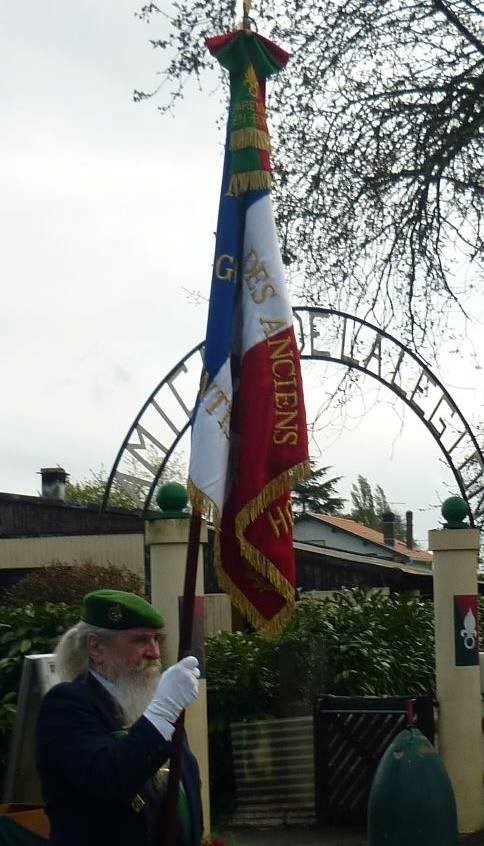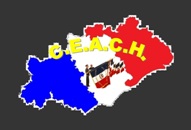The Recit du Combat de Camerone, is a tale recounted aloud around the world to Legionnaires on every post by the senior officer or senior noncommissioned officer present. It is commemorated each year by the French Foreign Legion on April 30, the anniversary of this battle.
Camerone was first celebrated on February 16, 1906, weather this was deliberate or not, the result of the decision was to award a Légion d'Honneur to the 1er Régiment Etranger in a ceremony that would eventually take place on April 30. During that same year it was changed and celebrated on it's proper anniversary.
During the war years, 1914-1918, up to 1920, Camerone was celebrated for reasons unknown. But, by 1920 the celebration of Camerone became an attempt to link the "New Legion" with the old one. The institutionalization of Camerone was established by General Paul Rollet, known as the Father of the Foreign Legion, he meant to establish this ceremony as a historical link between the "old" and the "new" Legion, and it was also a commemoration to those men who sacrificed their lives to the Foreign Legion. On April 30, 1931, General Rollet, made it official by inviting dignitaries, generals, foreign officers and delegates to Sidi-bel-Abbès, Algeria, (the home of the Legion until 1962) to be part of the celebration. The ceremony opened up with a parade of all the Legion's units led by the pioneers, a recitation of an account of the battle and the appearance of the wooden hand of Captain Jean Danjou, paraded in a glass reliquary, as the Legion band played what is now the official version of the Legion march "Le Boudin", the high point of the 1931 celebration was the unveiling of the Monument aux Morts---a large metal globe upon which Camerone is marked by a gold star, and all the countries in which the Legion has campaigned are highlighted in gold, it sits on top a square marble base, surround by four legionnaires at each corner. They represent the Legionnaires of the Algerian campaigns, the Second Empire, the Tonkin Campaign and the RMLE (Régiment de Marche de la Légion Etranger) of the First World War. The anniversary of the 1863 battle of Camerone in Mexico offered a far more dramatic symbol of regimental legitimization, a more potent behavioral role model and an occasion for celebration.
After a civil war had ravaged Mexico from 1857 to 1860 and ex-Mexican President Miguel Miramon had covered his debts by selling valueless bonds to greedy Europeans, these incidents damaged the economy so seriously that the newly elected Mexican President, Benito Pablo Juarez, had to suspend payments of foreign debts. The countries with most to lose were, United Kingdom, Spain and France, whose creditors demanded action from their governments. Charles Louis Napoléon Bonaparte III, emperor of France also demanded action to secure his investment. But at the same time, he also aimed to install a strong Latin Catholic puppet government in the southern part of North America, to counter-balance the rising Protestant Anglo-Saxon rooted United States. To complete his personal objective he would place Archduke Maximilian of Hapsburg, younger brother of Kaiser Franz Josef of Austria, on the throne he created.
On 31 October 1861, United Kingdom, France and Spain sign a convention in order to get their payments, to help support the Conservative Party put the country back in order and the protection of Europeans, for many were killed during the civil war. As a guarantee the three European powers agree to occupy Mexican fortresses: Vera Cruz on the Atlantic, Cordoba, Orizaba on the road from Vera Cruz to Mexico City and Tehuacan. Juarez accepted this temporary control with the agreement that the allied powers did not put their nose in the country’s ‘sovereignty, independence and territorial integrity of the Mexican Republic’.
In December 1861 the joint European expeditionary force (7,000 Spaniards, 2,500 French, and 700 British Royal Marines) landed and occupied Veracruz. The British and Spanish recognizing that blood could not be got from a stone, after heavy losses from disease and guerrillas, withdrew the following April, Napoleon III refused to accept the humiliation of defeat. This left Charles Louis Napoléon Bonaparte III, free to pursue his Mexican conquest, and since the United States was involved in its own civil war, there was no one to deny him. When French troops attempted to march inland to occupy Mexico City, they were checked at Puebla on 5 May 1862 and were driven back to the beach where they had landed. It was clear that reinforcements would be required before the advance resumed again. By September, the French had ferried 30,000 men across the Atlantic. This larger army was dispatched to take and occupy Mexico City, but like many other occupying armies it would be trapped by the burden of fighting an endless guerrilla war in a country whose population was hostile to a government imposed on them from outsiders.
To begin, Mexico seemed a poor sort of place to seek immortality. Napoleon III seemed to have decided that his régiments étrangers were best left to continue as a labor force and police force at Sidi-bel-Abbés. It had been considered that the international forces of French, British and Spanish regular armies would have no need of the Legion or its fighting methods, for the French were laying sieges and concentration of large forces. The regiments' junior officers resented their regiments' status and fearing dissension and stagnation, sent a petition directly to Napoleon III for a chance to join the party, dubbed as the ‘Mexicana Affaire’. For the Legionnaires, Mexico conjured up visions of horsemanship, dancing girls, liquor, and military glory. Unknown to the Legion, Napoleon III was considering a plan to lease the Legion to Maximlian for ten years. On 19 January 1863, approval was received from Paris.
So, on February 9, 1863, two battalions, a headquarters and a supply company, totaling 2,000 men boarded the St. Louis and the Wagram, two French naval vessels, and the Finistère, a transport ship, which was used to carry their equipment and mules, and left from Mers el-Kébir, near Oran, Algeria. On 28 March 1863, the regiments disembarked at Vera Cruz, at the time, when the second siege of Puebla (March 10-May 19) was on it way.
By now, the campaign had become bogged down. About 150 miles inland, the forces of President Benito Juarez had decided to make another stand at Puebla, which was under siege by the French. The city consisted of 22,000 Mexican troops and 5,000 more were stationed between Puebla and Mexico City. French reinforcements and supplies were ordered up from the coast by the French commander-in-chief of the French forces in Mexico, General Elie-Frederic Forey, but, it required large number of troops to protect the supply line between Vera Cruz and Puebla, because it was under constant guerrilla attacks.
The Legion, with memories of the Crimean War and the Italian Campaign was cheerfully ready to join the fighting at Puebla but found itself, instead, manning a series of local guard posts near the coast and the task of escorting supply convoys along primitive roads. The conditions were so bad that a convoy would seldom cover eight miles a day. Not only did the terrain and climate prolong the journeys, but these conditions caused excessive fatigue and made legionnaires susceptible to yellow fever. General Forey, made no secret of why he had the Legion waste its fighting spirit in manning the lines of communications: "I prefer to leave foreigners rather than Frenchman to guard the most unhealthy area, the tropical zone from La Soledad to Cordoba, where malaria reigns." The general should had mentioned yellow fever, Vomito Negro, and other maladies, which rapidly started to take its toll of the regiment. The only solution to the problem was to march troops as quickly as possible through the disease-ridden coastal plain to the healthy highland town of Cordoba. Complications arose when Mexican guerrillas began to strike at the convoys. There was some action nevertheless, the Legion’s first fight took place when it was getting its bearings in early April. A large Mexican guerrilla band raided a railway work camp under the protection of a section (squad), but the band was badly mauled by the newcomers. During the fight Ernst Milson von Bolt, a Prussian lieutenant killed the well-known guerrilla leader Antonio Diaz in hand-to-hand combat. For this action he received the Légion d'Honneur.
To break the siege at Puebla and to pay the French soldiers besieging Puebla, General Forey had brought in some heavy guns, ammunition, food, the Army’s pay chest containing 4 million francs, and a host of other goods, which set off from Vera Cruz in a painfully slow convoy of 64 horse-drawn wagons on April 15. A few days after the convoy left Vera Cruz, on its way towards the Legion's command post on the upper slopes of Chiquihuite Mountains, the Legion's commander Colonel Pierre Jeanningros received orders to send two companies to meet the incoming escort at La Soledad (50 km from Chiquihuite), and then escort the convoy to Chiquihuite, where another unit would take over from there. On 27 April, he sent the 5th Company and a company of voltigeurs (light infantry). Both companies were under strength due to illness.
On April 29, an Indian spy arrived at Jeanningros’s HQ and reported that the convoy was going to be attacked, not by guerrillas but by three infantry battalions and several cavalry squadrons. The men in charge of the Mexican operation were Colonel Mariano Camacho and Colonel Angel Lucido Cambas, who had studied military science in France. The only details which the scout could not supply was the time and place of the attack.
Jeanningros estimated the odds and decided to send another company to go out on patrol and hopefully make contact with the convoy at Palo Verde and/or track the enemies movements if time allowed it. If no contact was made until Palo Verde it was to return to Chiquihuite. The company he detailed for this mission was the 3rd Company, 1st Battalion. The 3rd Company had a nominal strength of 120, but disease had reduced it to 62 men. The unit was made up of Austrians, Belgians, Germans, Prussians, Dutch, Poles, Swiss, Frenchmen, a Dane, a Spaniard, an Italian, and one American or Englishman, named Peter Dicken of Prussian origin. The age of the men varied from seventeen years old to mid-40s. Some had interesting histories. Corporal Evariste Berg for example, was an officer in the French army and a Légion d'Honneur Medal winner, who had served in Crimea, Italy, North Africa and Syria. Discharged for misconduct, he rebuilt his life by enlisting as a private in the Foreign Legion. Or, Louis Maine, who at 18 left the family business and joined the 1st Zouave Regiment for a few years, then return to civilian life. When the Crimean War started he reenlisted in his old unit, he fought at the battles of Sebastopol and Malakoff were he won the Légion d'Honneur. On deciding to join the Legion he gave up his sergeant stripes and became a private, but three months later he became a corporal. Others were unknown as the case of Legionnaire Luitpog Van Opstal or Legionnaire Hiller, who’s first name is unknown.
The 3rd Company's officers were all sick, Jeanningros detailed the battalion adjutant a member of the headquarters staff, Captain Jean Danjou, 35 years of age, a decorated veteran from the Italian and Algerian Campaigns and the Crimean War, in which he received the Légion d'Honneur Medal, and who's left hand, amputated after an accidental explosion, had been replaced by a carved and articulated wooden hand with flexible joints, attached to his wrist by a long, deep leather cuff, volunteered to take the company out. Despite his amputation he had no difficulty controlling his horse or anything else. Two subalterns from HQ company, both former sergeant-majors promoted out of the ranks, joined him. They were Sous-lieutenants Clément Maudet, the standard-bearer and Jean Vilain, the paymaster. Lt. Vilain 27 years old, was an adventurer who joined the Legion at 18. He had received the Légion d'Honneur for gallantry at Magenta and won a battlefield commission during the Crimean War. Lt. Maudet, 34 years old, was a writer and a revolutionary from the 1848 crisis made him join or hide in the Legion. He had been awarded the British Crimean Medal for his part in the Battle of Inkerman and the Médaille Militaire for bravery during the Crimean War.
Col. Jeanningros handed the movement orders to Capt. Danjou saying "Take the 3rd and leave here after midnight and reconnoiter the area going towards the water hole at Palo Verde and the surrounding area, and to reinforce the incoming convoy if encountered. You should arrive at the water hole at daybreak. Engage any enemy you might encounter, if needed. ". At around 23h00, Danjou held appel (roll call) the 3rd consisted 62 legionnaires of the 120 men of a regulation company and two lieutenants.
Between midnight and 01h00 on Thursday morning of April 30, 1863, with rations and spare ammunition on mules, the men marched out from Chiquihuite towards Palo Verde. In the cool of the night they marched smoothly and quickly, by 02h30 they reached a post held by the battalion's grenadier company at Paso del Macho. There they stayed briefly for a brew of coffee and some black bread. The grenadiers' company commander, Captain Gustave Saussier, offered Danjou to reinforce the company with a platoon of his own men when he heard of the strength of the enemy waiting to ambush the convoy. Danjou, anxious to get on his way and cover as much ground as possible in the cool of the night, declined the offer. The march resumed. The company drummer, Legionnaire Casimir Lai, followed the officers on foot. On a routine march his drum would mark time for the men, but today on a reconnaissance patrol in hostile territory this was out of the question. Then came the rest of the company, followed by the rearguard, who where the company's most experienced men commanded by an experienced NCO, Sergeant Louis Morzycki, an Italian Campaign veteran and son of a Polish officer who took refuge in France and a French mother.
Danjou pressed on, and at first light, they saw that the countryside rolled down-hill to the Jamapa River. This was just as well, since it was going to be a very hot day for route marching. Without seeing anyone, they quietly passed several settlement, including Camerone, a ramshackle collection of farmhouses inhabited by vultures.
A mile or two beyond lay the deserted hamlet of Palo Verde, the limit of their patrol. The area was silent and empty, at the same time it had an eerie feeling. On reaching the ruins of Palo Verde at 07h00, the company fatigued by the long morning's march, paused for breakfast on a small hill near a lake and the ruins of Palo Verde. Sentries were set, wood was gathered, and fires lit. The operation was done by the book, the company was in a close drawn perimeter. The men then stretched out and joked among themselves. Most of the men were veterans of the Crimean War and the Italian Campaign, and so they were enjoying the easy life in Mexico. The battles were infrequent and the Mexicans, when they met the Legionnaires in battle, proved to be easy victims.
Somewhere up ahead from the east, the convoy would be laboring toward them with news from France and the security of increased numbers. As the Legionnaires talked of the girls they left behind and of their current loves, before breakfast could be eaten and coffee drunk, sentries signaled that a dust cloud was approaching from the west. "Mon Dieu!" Maudet said to Danjou, "Look at them! Isn't that a beautiful sight?" The rest of the company also began to look in the direction Maudet indicated. The early morning sun reflected off their side arms and rifles, as these fine horses and riders handled themselves in a precise military formation. "It doesn't make sense," said a Legionnaire to another. "They sent us out, 65 men and officers, to clear the way for an army. Are we the tail that wags the dog?" The Legionnaires near him laughed, but the laughter did not last long, for when Capt. Danjou raised his field glasses to get a better look he saw that they were Mexican cavalry and not French. The time was 08h00.
"Aux armes! L'ennemi" shouted Danjou. The barren spot he had chosen to rest was no place to meet the oncoming Mexicans, he decided at that moment to head back to the tumbledown collection of farm houses near Camerone which they had passed earlier, about half a mile or so away. Fires were doused, Legionnaires took up their arms and the mules were hastily packed. Danjou countermanded "Columns of files! Form along the road and we'll try to make it back to the hacienda Camerone." (actually known as hacienda de la Trinidad). Danjou moved his troops out of the open and into the bush to the north of the road. The company began to march westward towards the hacienda with scouts out ahead, the main body moved in two parallel platoon columns which could quickly be formed into a single square if the need arose. All went well until the company neared Camerone, where a single shot cracked out, Legionnaire Pierre Conrad rolled in the dirt, wounded in the hip. A number of Legionnaires rushed the hacienda only to find the sniper had vanished. Danjou gathered his men and resumed the march with the intention of trying to reach the nearby Indian village. However, alerted by the sniper shot, the Mexican cavalry was on its way.
After about a mile, a Mexican cavalry squadron under Joaquim Jimenez spotted the Legionnaires 300 meters away. The Mexicans quickly divided into two groups and advanced simultaneously to attack from different directions, coolly approaching the Legionnaires at a walk to within 75 meters. On seeing this Danjou shouted to his Legionnaires, “Formez le carré! Vous n’ouvrirez le feu qu’a mon commandement!” (“Form the square! Don’t open fire until my command!”), while Vilain, Maudet and Sargeant-Major Henri Tonel, a former actor, tightened up the square, forming into a back-to-back square. Kneeling and standing, the Legionnaires looked at the walls of incoming horsemen. Then the Mexicans charged, sabers flashing, yelling out "Viva Mexico! Viva Juarez!" At 50 meters, Danjou roared, "Feu!" ("fire!") and the first thirty rounds exploded into the horsemen. He repeated the order and another thirty weapons went off. Danjou then ordered, “Feu à volonté” ("Fire at will!") Mexican saddles were emptied and horses went down. Their attack blunted, the Mexicans drew off.
While the Mexicans reorganized, He moved his troops a hundred meters to the west onto a small rise surmounted by hedges of cactus. Once reorganized, the Mexicans crossed the road in front of the company and charged again. Danjou ordered his men to form the square and waited until they were a hundred meters away before he unleashed a volley that shattered the charge. During this confusion, frightened by rifle fire, the mules carrying the food, water and ammunition broke away into the scrub. The Mexicans, their attack blunted for the second time, wheeled away, but began circling the little square.
The clearing was no place to fight off cavalry, Danjou decided they would fight their way into Camerone. He ordered the Legionnaires to rush the Hacienda de la Trinidad, (Camerone) a square walled farmyard that stood about 300 meters east from their present position. With bayonets gleaming silver they charged through the thick ranks of the Mexican cavalry yelling "Vive l'Empereur!" "Vive le France!" and "Vive le Legion!” coming out with bayonets and uniforms drenched in blood. Within fifteen minutes of the running fight, Danjou, the two officers and 46 Legionnaires, some already wounded; Legionnaire Lai staggered in with seven lance wounds, took cover behind the walls of the deserted hacienda flanking the road. The large rickety wooden gates were rapidly slammed shut and openings in the walls were barricaded with timber or other material they could find. Their refuge consisted no more than the farmhouse and a walled courtyard in one corner of which was a ramshackle lean-to stable block. Danjou deployed his men at strategic points around the courtyard and buildings, some at windows in the farmhouse, others inside and on top of the stable block, and more still lining the walls of the yard at improvised loopholes.
Danjou now had two problems, the first, he could not see who was coming or going. So Sergeant Morzycki was hoisted onto the roof and climbed the highest point of the roof of the stable block and reported seeing hundreds of Mexicans surrounding them. From this point on the company prepared to defend itself until the relief column could come up and save them. But, there was no doubt in the minds of the Legionnaires that they could not hold out. The other was they were being harassed by some Mexicans on the upper floor of the house, attempts to eject the latter failed as there was no direct access to them. This meant that a portion of the Legionnaires always had to be directed against the enemy within, whose fire covered parts of the courtyard.
Meanwhile, the Mexicans also regrouped, with every able-bodied Mexican who could carry a firearm moved into position. The fight, which began in earnest, was an intimate and leisurely affair in which Mexicans tried to creep up on the Legionnaires to pick them off at point blank range or rush the weak points along the stable. About an hour's march away, a cavalryman had reached the Mexican encampment under the command of Colonel Francisco de Paula Milan, governor and provincial military commander of Vera Cruz. His reaction erred on the side of overkill. He ordered his three infantry battalions to move out and head for the scene.
At 09h30, the Mexicans ceased fire, put up a white flag and sent Lieutenant Ramon Laine, son of French immigrants, to the main gate of the hacienda, offering a honorable surrender. He called upon Danjou saying "You have earned our admiration, I guarantee you and your men safety and the best we can offer you as prisoners." Danjou "NON!" Lt. Laine, "But there is only a handful of you, and you haven't a chance. My army is 2,000 and we have more men on their way here. As a fellow soldier, not as an enemy, I ask you to surrender." Danjou responded with “Merde! We have enough ammunition. No surrender!" Danjou sent him packing.
During this brief truce remembering the men's thirst, hot, fatigue, and haggard, but still unafraid, he asked Legionnaire Ulrich Konrad to bring out the liter of French wine that he had carried from Chiquihuite. Danjou, crawling on his hands and knees, visited and checked each area of the defense perimeter, he then dispensed the wine, giving each man one sip. As though it were some sacred communion, he made them swear an oath, " You promise me to die rather than surrender?" Each answered, " Oui, mon capitaine,". Appel nearly completed and the last oath delivered, Mexican bullets began to fly.
The Mexicans threw the power and fury of their army at the Legion unit. Bullets whined through the gates and breach, kicking up dust spurts, and ricocheting off the wall; the Mexicans stormed the openings, but moved so awkwardly in their heavy leather chaps that the Legionnaires picked them off by the dozen with withering blast of point-blank rifle fire, butt strokes, and bayonet thrust in the corral. "Make each bullet count" Danjou yelled. The Mexicans who got through to the Legionnaires never returned to their group. The dead of both French and Mexicans littered the corral and the floors of the sheds as the assault followed assault. Yet, the 3rd Company did not weaken its spirit only in numbers. By 11h00, Danjou had lost twelve men.
This was not mere death-or-glory bravado. By now, Danjou was aware that this Mexican force was the one assembled to attack the convoy. Furthermore, because of the casualties they had sustained, they allowed themselves to become embroiled in a pointless battle with a half-strength Legion company, which should have been contained while the primary mission continued. Surrounded in the hacienda under the blazing sun the Legionnaires presented no serious threat to the operation and in due time thirst would have compelled them to surrender without another shot being fired. That, however, was not the enemy’s inclination and Danjou decided that it would be the convoy’s benefit if he continued to absorb their attention as well as writhing down their strength to the best of his ability.
The fighting continued, between 11h00 and 11h30 while darting across the courtyard to check one of his defences, Danjou was hit in the chest by a sniper who had taken control of one of the upper storey rooms of the house. Sous-Lieutenant Jean Vilain, who until four months before was a NCO and another Legionnaire darted to Danjou's side to check his condition and dragged him to safety. Danjou shook his head and whisper "NEVER….", then writhed in pain, breathing his last breath. No more thought of surrender, Vilain took his medals and sword assuming command of the thirty-two remaining Legionnaires of the 3rd Company, 1st Battalion of La Légion Etrangère Française. Wiping the tears and sweat from their eyes, the Legionnaires turned to their gun ports and barricades, to ready themselves for another Mexican attack.
Another attempt was made by the Mexicans to get into the farm, but it was beaten with ease. But by noon, the company's youngsters, (nos benjamins) Jean-Louis Timmermans was mortal wounded (he later died in prison from two gut wounds), and Johan Reuss was killed. They were seventeen and this was their first engagement. A few others were also killed or wounded. Somewhere beyond the walls, the Legionnaires heard the sound of drums and bugles. They were convinced it was a relief column. Legionnaires cheered "They've come! We are saved!", as they listened to the sweet sound of the bugles and drums of the incoming troops. But, Sergeant Morzycki still on the roof reported to Lt. Vilain, that he estimated that they were 1,000 Mexican infantrymen, worse yet, they were armed with American Spencer and Sharp carbines, which are much better than the French Minie rifle, and they also brought a canon. Waving in the wind, the colors of the units were identified as the Vera Cruz Battalion, the Jalapa Battalion, and the Cordoba Battalion commanded by Colonel Francisco Milan. Col. Milan, detailed to attack the convoy, had diverted his units to complete the destruction of the Legion company.
By 13h00, the legionnaires were out of water and the oppressive heat began to torture the men with thirst, but their fighting spirit still strong. Once again, Lt. Laine asked, "I renew my offer to accept your surrender and guarantee your safety. Your bravery is wonderful, but fruitless." Vilain gave the same answer as Danjou had uttered. "Merde!" Lt. Laine, the Mexican officer said, "Then prepare to die then!" Indeed, the Legionnaires did prepare to die, but to die fighting. Completely hopeless, dying of thirst, being beaten by the merciless sun, sharing their last meager rations, and certain of death the remaining men braced themselves for the incoming onslaught.
Around 13h30 the battle resumed. The Mexicans swarmed the entire building and poured death down on the Legionnaires. The enemy also began digging holes with pickaxes in one of the walls that protected the Legionnaires to try to gain an easy access into the courtyard. Both Legionnaire and Mexicans dead and dying laid sprawled in and around the courtyard. The Mexicans sent wave after wave at the 3rd Company, who threw back everything the Mexicans had to offer. At 14h00, during one of the assaults, Lt. Vilain went to check a defensive position at the south end of the courtyard. On his way back to one of the gates at the west wall, a sniper from the upper storey rooms shot him in the forehead, killing him instantly.
The Legionnaires drove back the assault and Lt. Maudet, another ex-sergeant-major, succeeded him, at the point which all his men were being driven half mad by thirst. According to the survivors' reports of the battle, they claimed to have witnessed some of the wounded drinking their own blood and urine as they pressed hard against the walls to avoid the gunfire and heat that transformed the courtyard into an abattoir.
As the afternoon wore on causalities mounted: Company Sergeant-Major Herni Tonel, a burly ex-actor; Sergeant Jean Germays, Alfred Palmaert, and Charles Schaffner; Corporal Adolphe Del Caretto, Ame Favas and Andre Pinzinger; Legionnaires Aloisio Bernardo, Claude Billod, Antoine Bogucki, Constantine Dael, Charles Dubois, Peter Dicken, Frederic Fritz, Frederic Friedrich, Emile Hipp, Jean Kurz, Louis Rohr, and Luitpog Van Opsal. Ammunition was beginning to run low, so, the living rummaged through the pockets and pouches of the dead men, seeking unused ammunition. The 3rd Company had been fighting for a full eight to nine hours.
Towards the end of the afternoon the Mexicans increased the suffering of the Legionnaires, by igniting bales of straw piled against an the exterior wall. The Legionnaires' response was to fire at anything that moved towards them through the smoke, the smoke began to asphyxiate and blind the men, and the heat of the flames added to the terrible thirst that tortured them. One by one the men of the 3rd Company fell, but those remained standing continued to load, aim, fire at the charging Mexicans, who were dropping like flies round the Legionnaires. They faced the Mexicans and fought with ferocity that kept the battle raging on. The areas in front, in back, and on the side of them were carpeted with Mexican dead and wounded. The Legionnaires never thought of quitting.
By 17h00, there were only twelve legionnaires left standing. They were Lt. Maudet , Sergent Morzycki, Corporal Berg, Maine and Charles Magnin, Legionnaires Gustave Bertoletto, Victor Catteau, Laurent Constantin, Leon Gorski, Hippolyte Kunassek, Jean-Baptiste Leonhart, and Geoffroy Wenzel.
The Mexicans had suffered causalities running to three figures. Colonel Francisco Milan made an impassioned speech about his country's pride and honor in which Legionnaire Bertoletto translated to French (Bertoletto was a Frenchmen who spoke Spanish). In addition, he was losing men left and right and losing face. The gallantry of these Legionnaires was one thing, but the terrible cost the Mexicans were paying was now the most apparent side of the coin. Another surrender offer was made and refused, so, the Mexicans lined up for a large scale charge that would overwhelm these fanatical foreigners once and for all.
The Mexican infantrymen, in formation, rifles ready and bayonets fixed, charge the hacienda. The earth around Camerone thundered to the trampling of hundreds of feet as the assault rolled forward towards surviving Legionnaires. With extraordinary audacity and courage, the Legionnaires met the charge. But, within 45 minutes the gallant Sergeant Morzycki, Legionnaires Bertoletto were dead, the others were wounded and the Mexicans had taken the farmhouse. By 18h00, there were six men left: Sous-Lieutenant Clément Maudet, former NCO and Légion d'Honneur winner at the Battle of Magenta, Corporal Louis Maine, still wearing his medals given to him for the assault on Fort Malakoff at Sebastopol, who wrote about his experiences and life in the Legion and had given up his sergeant stripes to fight in Mexico, Legionnaires Victor Catteau, a Belgian with six months of service, Laurent Constantin, a Belgian who was the company’s jokester and Bapitiste Leonhart, another Belgian, Geoffery Wenzel a German Legionnaire veteran of many years. Each man had one round left, Lieutenant Maudet ordered the Legionnaires to fire their last volley. Their ammunition expended, the end had clearly come, but true to the promise they had given Danjou, they refused to surrender. Instead, they wrenched a barricade aside and charged with fixed bayonets into the Mexican ranks, stabbing with their bayonets and clubbing with their rifle butts. The Mexicans in front of them crumpled and the Legionnaires attacked the men who took their place.
There was no halting this human sea of soldiers. They were then met by a volley and Catteau, hurled himself in front of his officer to make a shield with his body, dying with 19 bullets in his body. Still, Maudet fell with two bullet wounds and Leonhart was mortal wounded. Wenzel also fell, wounded in the shoulder, but got up immediately. Maine and Constantin were uninjured.
The three legionnaires jumped over Maudet, Catteau, and Leonhart’s bodies and stood back to back. The Mexicans seemed awed, and for a moment no one made a move. The Mexicans then surrounded them with bayonets pointed at their chests. The Legionnaires took their last breath when Colonel Angel Lucido Cambas, burst through his ranks and thrusted his men to one side and stepped slowly between the two groups, a risky maneuver in a situation that might have exploded in a second.
" Vous rendez-vous, cette fois?" (Do you now surrender?) Col. Cambas asked in French." Only if you allow us to keep our weapons and equipment and treat our wounded lieutenant here?" Maine asked." One refuses nothing to such men as you." Col. Cambas responded. Soon afterwards, the wounded were cared for and the men fed, they were treated more like honored guests than prisoners of war. They were then taken behind a small rise where Colonel Milan was. Col. Milan on seeing the survivors was perplexed and looked for the others, asking, "Is this all that is left?" Col. Cambas answered, "Si, Colonel!” Col. Milan surprised with the answered, exploded saying “Pero non son hombres, son demonios!" ( "Yes sir, for these are not men, but devils!").
The landscape of Camerone looked as though it had been the scene of the greatest battle in the history of professional soldiery. The battle had lasted 11 hours. About 300 to 400 Mexicans laid dead, dropped by the deadly fire of the Legionnaire’s marksmanship (the Legionnaires fired 3,800 rounds (each soldier carried 60 rounds of ammunition) of which one in ten found its target. Most of the shot were head or chest shots). A several hundred Mexicans crawled and squired on the field, wounded by the tigers of the 3rd Company, 1st Battalion. The Mexicans were as good as their word. The buildings were searched for the wounded, and were treated including the Legionnaires. Seven, including Maudet died in captivity, but sixteen survived and, together with the few other survivors that were captured during the running fight into the courtyard were later exchanged for an equal number of Mexican prisoners a month later.
On the evening of the 30th, Colonel Jeanningros received news of the Camerone engagement from local Indians. In the early morning hours of May 1, he set off with a relief column to learn for himself of the incident. At first the small relief column headed down the same road that the 3rd Company had taken, but he then decided to change route and bypass Camerone to link up with the incoming convoy and then head towards Camerone with a larger force to see the damage. But, on the road towards Camerone, before changing course, the column came upon a heavily bloodstained figure in Legion uniform lying beside the road. It was Danjou's drummer, Legionnaire Lai, who had sustained seven lance wounds and also had been shot twice during the defense of the farm. He had been left for dead when the wounded were removed and found himself lying under a pile of corpses when he regained consciousness. In spite of his wounds, he dragged himself for two miles before collapsing. From Lai, Jeanningros was able to confirm the strength and professionalism of the opposition. He later received the Légion d'Honneur. His decoration can be seen at the Legion Museum in Aubagne near Marseilles.
Jeanningros decided to head for Camerone. On reaching the hacienda, now pock-marked by thousands of bullets, he found that the Mexicans had removed all traces of the battle. A quick search of the area revealed the bodies of the missing men, in a ditch feeding the vultures. Fearing that Milan’s force might still be in the area, not wishing to share the same fate, Jeanningros emulated Danjou's initial maneuver, taking to the bush to make a covert return to Chiquihuite. The dead were to remain unburied for another two days. Jeanningros returned to Chiquihuite, to assemble a more formidable force.
Down towards the coast at the settlement of La Soledad, the convoy commander--- also alerted to the presence of Milan's troops---waited until his escort could be beefed up. On May 3 the two French forces finally met up at Palo Verde. Also on that day, the dead of Camerone (what was left of them) were buried with military honors.
Sometime later amid the debris, a local rancher supposedly named Langlais picked up by chance an organ less vulnerable to predators. This was Danjou's wooden left hand. He kept it as curiosity for two years then, having learned something of its history, offered to sell it to General Achille Bazaine, a former Legion officer, who succeed Forey as commander-in-chief of all French forces in Mexico, at a price of 50 piastres. After four months of haggling, Bazaine paid the ransom and the hand was returned to Legion Headquarters at Sidi-bel-Abbes. Today, the Hand of Danjou, the most treasured of all Legion relics, is housed in the Legion’s Salle d’Honneur in Aubagne. It is a symbol of Legion durability--for the Legion never surrenders. At Camerone in 1892 a monument was erected that reads: "Ils furent ici moins de soixantes opposés à toute une armée. Sa masse les écrasa. La vie, plutôt que le courage, abandonna ces soldats français le 30 avril 1863." (They were here less than sixty opposed to a whole army. Its mass crushed them. Life, rather than courage, abandoned the French soldiers on 30 April 1863.)
Three officers and 29 men died; 25 at the hacienda and seven in prison. Four others disappeared. The three legionnaires who were still alive at the end of the battle were not the only survivors. According to records and later roll calls, there were 24 other legionnaires. They were: Sergeants Jean Germeys, Alfred Palmaert, and Charles Schaffner; Corporals Evariste Berg, Charles Mangin and Andre Pinzinger; Legionnaires Claude Billod, Felix Brunswick, Pierre Conrad ( Danjou’s batman), Frederic Fritz, Constant Dael, Aloise Gaertner, Leon Gorski, Hiller, Adolphe Jeannin, Hippolyte Kunassec, Joseph Rerbers, Joseph Schreiblich, Hermann Schiffer, Jean Seffrin, Pharaon Van Den Bulcke, Jean-Baptiste Verjus, Nicolas Zey, and the drummer Casimir Lai.
Maudet died several days later in a Mexican prison hospital. Returned from captivity, Louis Maine was promoted to Sous-Lieutenant, but later quit the Legion to reappear in another regiment as a captain in the Franco-Prussian War. Corporal Berg also received a commission, but was killed two years later in a duel with another officer; one story has it that his opponent was Maine. Wenzel, received the Légion d'Honneur and Kunassek, received the Médaille Militaire, both veterans of 15 years each, serving for several more years and went on to enjoy the rest of their years in peace. Sgt. Schaffner, Cpl. Pinzinger, Legionnaires Brunswick, Constantin and Fritz received the Légion d'Honneur. The rest received the Médaille Militaire. Little else is known of what became of the survivors of the 3rd Company.
The self-sacrificial stand of the 3rd Company had shaken Milan so badly that he made no other attempts to attack convoys in Legion-controlled territory. The arrival of the cannons at Puebla proved decisive. The fortress fell on May 17 and the road to Mexico City was open. Maximilian was enthroned the following month, but the war continued for four more years. But the Mexican campaign was overshadowed with intrigue, domestic as well as political. Pressures from Prussia, which lead to the Franco-Prussian War in 1870, the United States which did not fancy having the French on their doorstep and began to support the fugitive Mexican president Juarez by sending weapons and other supply, internal French political debacle and the overall losses which France sustained in the war (250 million francs and 7,000 lives), made it inevitable that Napoleon III would withdraw his forces. Another contributory factor may have been Napoleon III’s suspicion that the Legion veteran General Achille Bazaine, who later became Marshal of France—had flirted with the idea of a coup d'etat in Mexico.
By early 1867, Napoleon III ordered the withdrawal of the 28,000 French troops in Mexico, within eight weeks they were home. Like America’s Vietnam War veterans these French soldiers found no customary ceremony with which France normally greeted her soldiers returning from war. As for Maximilian refusing to desert his loyal followers was captured and executed on 19 June 1867. The Legion spent five years in Mexico. Those years yielded their share of military gallantry, for there were other battles which litter the Legion’s combat record during the Mexican adventure. On 18 February 1867 the 1st Battalion of the French Foreign Legion boarded the La Pomone and headed towards Algeria.
Napoleon III later ordered that the word "CAMERONE" with the names of Captain Danjou, and Lieutenants Vilain and Maudet be inscribed in gold on the walls of Les Invalides in Paris. He also had Camerone sewn on the regiment's banner. Today all the French Foreign Legion regiments have 'Camerone 1863' sewn on their banners. Of all the scores of battles fought by the Legion, this is one of the most highly regarded and celebrated annually (next to Christmas) with all the pomp and ceremony that the Legion can muster. Camerone Day, April 30, is without a doubt one of the most important days in the Legion calendar. Thus was the end of the battle and the beginning of one the greatest legends in the annals of professional fighting men. Although Camerone was a marginal event during the Mexican campaign, the event in the eyes of the Legion confers upon in the Legion a reputation of a troop capable of making the supreme sacrifice. It has become an inspiring example to all Legionnaires of heroism and courage.
Other Reading:Pierre Sergent, Camerone, 1980.
James W. Ryan, Camerone, Greenwood, 1998.



































